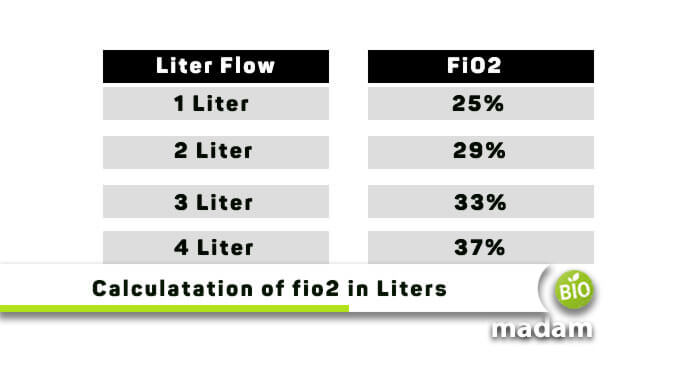The term FiO2 stands for “the fraction of inspired oxygen,” which is the oxygen content all of us inhale daily. In other words, it is the volumetric or molar fraction of oxygen in inhaled gases, thus, helps to exchange gases at the alveolar level.
Whenever a patient finds difficulty in breathing, it means he’s at lacks oxygen concentration. Such patients are given oxygen-enriched air in these cases, usually having FiO2 higher than the normal air. Our natural environment typically consists of 21% oxygen (21% FiO2), but when given to a patient to treat his medical ailment, the FiO2 concentration may extend up to 99% oxygen. Doctors usually recommend keeping the FiO2 volume low up to 50% (0.5) to avoid toxicity despite having this broad range.
How Do We Generally Estimate the Effective FiO2 Concentration?
The percentage calculation of oxygen received by a given flow cannot be precise every time, but relatively accurate estimation can be obtained by relying on some guidelines.
The percentage is indicated by comparing FiO2, a fraction of inspired oxygen in the air, to a transportable oxygen device. We can gauge effective FiO2 under normal conditions through a general rule of thumb. Let’s check them out under different LPMs (liters per minute).
| Liters Per Minute (LPM) | Effective FiO2 |
|---|---|
| 1 | 24% |
| 2 | 28% |
| 3 | 32% |
| 4 | 36% |
| 5 | 40% |
| 6 | 44% |
| 7 | 48% |
| 8 | 52% |
| 9 | 56% |
| 10 | 60% |
Oxygen Percentage at 1 Liter per Minute:
The estimated FiO2 is 24% at 1 LPM
Oxygen Percentage at 2 Liter per Minute:
The estimated FiO2 is 28% at 2 LPM
Oxygen Percentage at 3 Liter per Minute:
The estimated FiO2 is 32% at 3 LPM
Oxygen Percentage at 4 Liter per Minute:
The estimated FiO2 is 36% at 4 LPM
Oxygen Percentage at 5 Liter per Minute:
The estimated FiO2 is 40% at 5 LPM
Oxygen Percentage at 6 Liter per Minute:
The estimated FiO2 is 44% at 6 LPM
Oxygen Percentage at 7 Liter per Minute:
The estimated FiO2 is 48% at 7 LPM
Oxygen Percentage at 8 Liter per Minute:
The estimated FiO2 is 52% at 8 LPM
Oxygen Percentage at 9 Liter per Minute:
The estimated FiO2 is 56% at 9 LPM
Oxygen Percentage at 10 Liter per Minute:
The estimated FiO2 is 60% at 10 LPM
Hence, we can analyze a 4% increase in FiO2 for every LPM use of oxygen from portable oxygen concentrators.
Formula to Calculate FiO2 Percentage
There is a general formula to calculate FiO2 under normal conditions, which is as follow:
FiO2 = 20% + (4 x oxygen liter flow)
This formula is limited to normal circumstances. Several factors are affecting our FiO2, which include:
- Breathe Size – how small or large it is.
- Breathe Rate – how slow or fast the person is breathing.
- Inspiratory Flow Rate – affected by both breath rate and breathe size.
- Different types of oxygen tubes affect the flow.
Oxygen Flow Range Decision
| Oxygen Supply Source | Liter Flow Meter |
|---|---|
| Nasal Cannula | 1-6 liters |
| Simple Face Mask | 5-12 liters |
| Partial Rebreather Mask (35-60)% O2 | 8-15 liters |
| Partial Non-breather Mask (60-90)% O2 | 8-15 liters |
| Venti Mask (24-50)% O2 | 15 liters |
Health care providers are trained in monitoring and considering the patient’s condition when deciding about the oxygen flow.
- When oxygen is provided using a nasal cannula, the liter flow will be set between 1 and 6 liters.
- Utilizing a simple face mask sets the meter between 5 and 12 liters. Never keep the meter below 5 liters if you’re using this type of mask.
- For a partial rebreather mask with 35 to 60 percent oxygen, the liter flow must be set between 8 and 15 liters. The bag must always be kept half-inflated. If the bag is not inflated enough, then you have to increase the oxygen flow.
- A rebreather mask and a non-breather mask look similar, but a non-breather mask delivers a high oxygen concentration. So, for a non-breather mask, the liter flow goes between 8 to 15 liters, with the oxygen percentage ranging between 60 and 90. The bag must be kept inflated, and the liter flow must never be decreased to less than 8 liters.
- If the patient uses a venti mask for oxygen, the flow meter is always set at 15 liters. The mask has different color-changeable plastic pieces. Besides, each color signifies a different oxygen delivery percentage. Being said that, it can deliver between 24 to 50 percent of oxygen.
The oxygen flow can only be changed by altering the plastic adaptor. Not following the protocols can cause serious O2 toxicity. You must never decrease or increase the oxygen flow without your doctor’s permission.

Amna being a Physicist wants to share her subject expertise and knowledge with people. Amna is a highly energetic and motivated lecturer as well.


If each letre corresponds with a 4 percent increase in FiO2, from .21, shouldn’t the increments be 25, 29, 33, etc? Not 24, 28, 32, etc?
Round down. .21 is closer to 0.
Same question. But I have found other articles where they start at 25% instead of 24%.
21 dont take it like closer to 0, the patient is only on room air .
(always 1 or 1+ amount oxygen is given to a patient regardless of the device) Therefore, 1 liter of oxygen supplied = 24% fraction of inspired oxygen ( = that’s the amount of oxygen patient is getting) that’s the starting point ( don’t know where the 21 in your question came from)
then 2 liter = 24+4= 28%
then 3 liters = 28+4= 32% then on and on . Hope it helps
His/ her 21% comes from the percentage of FiO2 at room air, which is 21% or 0.21
Correct
For perfectionists :
FiO2 = 21% + (lpmO2 *(1/(4*MV))
LPMO2 = liter per Minut O2
MV= minute ventilation
NB : this formula is only applicable if the I/E ratio is equal to 1/2 !
Ref: Duprez F, Mashayekhi S, Cuvelier G, Legrand A, Reychler G. A New Formula for Predicting the Fraction of Delivered Oxygen During Low-Flow Oxygen Therapy. Respir Care. 2018 Dec;63(12):1528-1534. doi: 10.4187/respcare.06243. PMID: 30467224.
1. iam asking to oxygen persentge room air 20 or 21
2. iam asking to fio2 colculate room air persentge add to3 or 4
How much flow would be required for 35% FiO2 with a tracheostomy?
How would the calculation differ here if we use an oxygen concentrator with the ventilator?